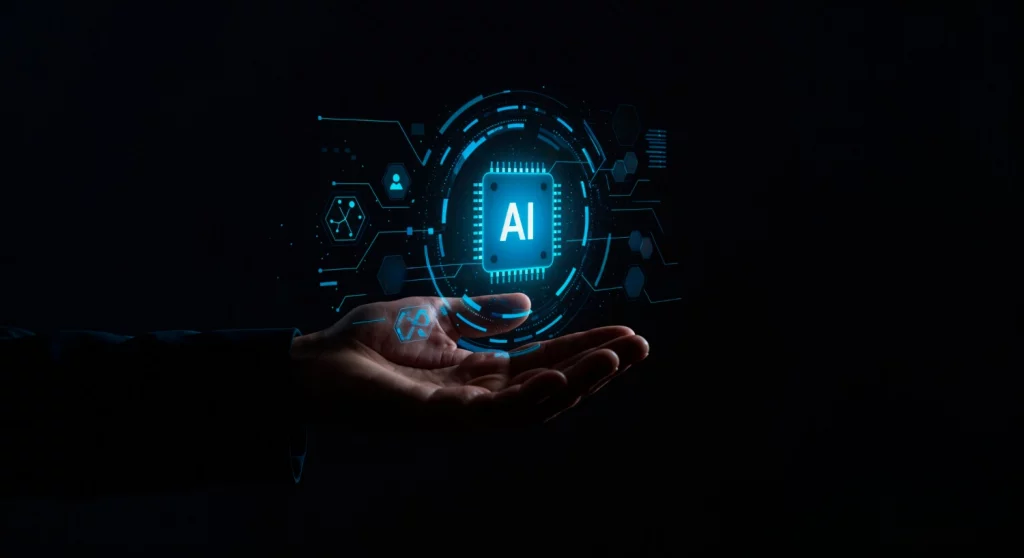Table of Contents
Listen to article
From uncovering actionable insights and automating tasks to creating more personalized user experiences and enabling faster, data-driven decisions, the value of AI in business acceleration is, in our opinion, undeniable.
And with 78% of respondents in a recent survey reporting that their organizations use AI in at least one business function, it’s clear that we’re not the only ones supporting AI innovation and adoption.
But AI tools don’t just grow on trees—they require a complex AI development life cycle, full of challenges and considerations every business needs to navigate.
By understanding the AI development life cycle, companies can more accurately address these challenges, set realistic expectations, and maximize the impact of their AI initiatives.
Dive into this topic with us, where we’ll cover the key stages of the AI life cycle, the main technologies and frameworks, tips for successful implementation, and more.
What is the AI Development Life Cycle?
The AI development life cycle is the structured process of designing, building, training, testing, deploying, and maintaining AI solutions to solve specific business problems. Think of it like building a high-tech factory—designing blueprints, assembling machines, testing output, and keeping everything running smoothly as demand grows.
From defining objectives and preparing data to training models and monitoring performance, this process relies on foundational technologies and pillars such as machine learning algorithms, large language models, and natural language processing to ensure scalable, reliable workflows.
Key Stages of the AI Development Life Cycle
So what are the must-know stages involved in the AI development life cycle?
We’ve broken them down into 7 key phases:
Stage 1: Problem Scoping
No matter what industry you’re in or how big your organization is, the AI software development life cycle should always start by defining the problem you’re trying to overcome. During this stage, you identify opportunities, set objectives, and establish criteria for success—aligning them with tangible business outcomes like cost savings, revenue growth, or improved customer experiences.
Stage 2: Data Discovery, Collection & Preparation
Just as we need food to survive, your AI solution needs data to fuel its capabilities. And not just any data—clean, well-organized, and relevant data that aligns with your industry and project goals. To achieve this, your AI development company identifies data sources, determines data types, and prepares them for training—ensuring the insights generated directly support business priorities, such as faster decision-making or improved customer targeting.
Stage 3: Model Definition & Design
During this stage, your development partner will select the appropriate algorithms and define the architecture best suited to your objectives, whether that involves machine learning models, deep learning networks, or natural language processing frameworks. This process includes setting key parameters, designing workflows, and determining how the model will integrate with your existing systems.
These choices ensure the solution not only functions technically but also drives outcomes like higher efficiency, better user experiences, or faster time-to-market.
Stage 4: Model Training & Development
Next, the model will be trained on the prepared data to help it learn patterns, rules, and relationships—providing the basis for informed predictions and decisions. Through iterative training, testing, and fine-tuning, the model’s performance is optimized to improve accuracy and reliability.
Stage 5: Evaluation, Testing & Validation
Next, the model must be evaluated and tested to see how well it performs. The goal isn’t just to create an AI model—it’s to uphold an ethical AI development life cycle. A key part of this is validating its reliability on unseen data and assessing metrics like accuracy, precision, and recall to ensure that the model performs as intended in real-world scenarios.
If it falls short in any area, it must be refined and improved to prepare it for the next stage.
Stage 6: Deployment & Iteration
And finally, the AI model is ready to be deployed. A key part of this is AI integration, which involves incorporating new AI tools into existing business processes, systems, and applications (don’t worry, AI integration consulting guides you step by step so you can make the most of your new AI tools).
Once deployed, the model’s performance is continuously monitored, and feedback is used to refine it over time so it can adapt to evolving business needs.
Stage 7: Monitoring, Maintenance & Continuous Learning
The last stage of the AI model life cycle is focused on monitoring performance, maintaining model accuracy, and enabling continuous learning to ensure the solution stays effective as your data and business needs evolve. Through regular updates, performance tracking, and feedback loops, your AI model can improve over time and continue delivering reliable results.

Challenges & Considerations for the AI Development Life Cycle
The AI product development life cycle is complex, meaning it comes with various challenges and considerations that can’t be ignored:
- Ethical and regulatory concerns: Discrimination, automation bias, privacy violations, and non-compliance with industry-specific regulations are all concerns throughout the generative AI project life cycle. Development companies must be aware of the factors that can lead to bias—such as training data, algorithmic bias, and temporal bias—to ensure compliance with AI laws.
- AI business readiness: Simply believing in the potential of AI isn’t enough—companies must be prepared to integrate new technologies into their workflows. To build AI readiness, companies should establish a scalable AI roadmap, invest in robust data management and quality, and equip their teams with the necessary skills to adopt and implement AI effectively.
- Leadership and liability: As AI systems grow more influential, leadership teams must take responsibility for their impact. As part of your company’s AI liability strategy, you should define clear governance structures, assign responsibility for AI outcomes, and stay informed on evolving regulations.
- Data quality and security: Incomplete or inaccurate data can lead to bias and discrimination, incorrect decisions, and security risks—all of which negatively impact operational integrity and your company’s reputation. To address this challenge, companies should adopt comprehensive data management strategies that prioritize accuracy and data quality.
- Implementation costs: AI implementation has high upfront costs but delivers long-term cost efficiency and a greater ROI. That said, there are various strategies to keep implementation costs manageable, such as creating a minimum viable product, leveraging existing infrastructure, and partnering with an experienced AI development company.
- Business disruption: Implementing AI can lead to changes in workflows, team structures, decision-making processes, and overall organizational dynamics—and if your company isn’t ready, these disruptions can reduce efficiency and lead to resistance from employees. To support a smooth transition, your company should develop a clear change management strategy, involve stakeholders early, and provide ongoing training to employees.
- Scaling: AI systems need robust infrastructure and large volumes of data to operate at speed and scale without compromising performance. That said, a system’s ability to scale should be considered throughout the entire AI model life cycle to ensure it’s able to accommodate growing data demands for years to come.
Main Technologies & Frameworks for the AI Development Life Cycle
Choosing the right technologies and frameworks for your project is key to achieving an efficient and scalable AI development life cycle. Here are some of the top AI development tools that you should know about:
For Data in AI Life Cycle
- Apache Kafka / Apache NiFi – for real-time data ingestion pipelines.
- PostgreSQL / MongoDB / BigQuery – to store structured or semi-structured data.
- Pandas / Dask – for data wrangling at scale.
- Labelbox / Prodigy / Scale AI / Label Studio / CVAT – for data labeling and annotation (especially in supervised learning).
- Great Expectations / Deequ – for data validation and quality assurance.
For Development & Prototyping in AI Life Cycle
- Scikit-learn – ideal for traditional ML (regression, classification, clustering).
- PyTorch – preferred for research, computer vision, NLP, and experimentation.
- Hugging Face Transformers – pre-trained models and finetuning/training library for NLP, vision, and audio.
- XGBoost / LightGBM / CatBoost – for tabular data and competitive performance in many ML problems.
For Experiment Tracking & Versioning in AI Life Cycle
- MLflow – for experiment tracking, model registry, and reproducibility.
- Weights & Biases – for collaboration, visualization, and hyperparameter tuning.
- DVC (Data Version Control) – for versioning datasets, models, and pipelines.
- Git / GitHub / GitLab – for code versioning and CI/CD pipelines.
- Tensorboard – popular tool for both PyTorch and Tensorflow.
For Training & Evaluation in AI Life Cycle
- Optuna / Hyperopt – for hyperparameter optimization.
- TensorBoard / WandB – for monitoring training in real time.
- Confusion Matrix / ROC AUC / Precision-Recall curves – built-in sklearn.metrics.
For Deployment in AI Life Cycle
- TensorFlow Serving / TorchServe / KServe – for serving trained DL models.
- AWS SageMaker / Azure ML / Google Vertex AI – managed platforms for end-to-end lifecycle, including deployment.
- Docker / Kubernetes – for containerization and orchestration.
- FastAPI / Flask / gRPC – for building AI model APIs.
- ONNX – for interoperable model deployment across frameworks.
- TensorRT/DeepStream – NVIDIA-hardware model optimization.
- Prometheus / Grafana – for tracking model and ML system performance.
For Governance in AI Life Cycle
- IBM AI Fairness 360 / Microsoft Fairlearn – bias detection and mitigation.
- Google What-If Tool – for interpretability and model exploration.
- Model Cards (by Google) – to standardize model documentation.
- OpenAI’s System Card – a model for transparent reporting on AI risks.
How to Successfully Implement an AI Development Life Cycle?
At Scopic, we know a thing or two about the AI development life cycle—and we’re all about sharing what works.
As an experienced AI consulting company, here are our top tips:

Start with a business-first mindset
If you’re considering implementing an AI solution, here’s one seemingly simple yet critical tip to keep in mind: it should solve real business problems and deliver measurable value. Rather than figuring it out as you go, aligning your AI strategy with your business goals helps you create real value—value that requires careful planning and continuous learning.

Involve cross-functional teams early
Involving a cross-functional team in the development process helps improve collaboration, mitigate potential risks, and enhance the overall understanding of the project’s goals. From data scientists and AI software engineers to UI/UX designers and project managers, every team member brings diverse skills and knowledge to the project.

Adopt a data-centric mindset
Data fuels AI algorithms, and gathering quality data is key to generating reliable outcomes. High quality not only means clean and accurate data but also data that is relevant to the “real-world” problem being addressed. Companies that view data as a foundation for a successful AI system are better equipped to develop models that drive meaningful business outcomes.

Build reproducible and modular pipelines
Creating consistent, repeatable workflows is essential for scaling AI development efficiently. Modular pipelines allow teams to reuse components, reduce duplication, and adapt quickly to new requirements or data sources. When workflows are reproducible, it becomes easier to track model performance, troubleshoot issues, and maintain compliance.

Optimize for interpretability and fairness
One of your main priorities should be building trust with your target audience—which means ensuring your AI business solution is transparent and understandable. Your development partner can accomplish this by implementing explainable AI techniques, documenting model decisions, and providing clear insights into how data influences outcomes.

Use the right evaluation metrics
Measuring the right KPIs is essential for evaluating the real-world impact of your AI system. Google Analytics identifies the most important KPIs to help track your model’s accuracy, operational efficiency, user engagement, and financial impact: model quality KPIs, system quality KPIs, business operational KPIs, adoption KPIs, and business value KPIs.

Plan for scalable deployment
Planning for scalable deployment ensures your AI solution can handle increasing data volumes, user demands, and evolving business needs without compromising performance. By designing with scalability in mind from the start, companies can avoid costly rework and accelerate time to value.

Embed ethical and legal considerations
Incorporating ethical and legal principles throughout the AI process is essential for minimizing risks and building responsible solutions. Prioritizing an ethical AI development life cycle helps ensure compliance with regulations, protect user rights, and promote fairness and transparency.

Consider a reliable AI development partner
By working with an experienced AI development partner, you can implement advanced features that overcome business-specific challenges, feel confident that you comply with regulations, and leverage AI software development process in the most efficient way possible.
The AI Development Life Cycle in the Future
The AI development life cycle is constantly evolving—meaning businesses must stay on top of new trends to stay competitive. Scopic stays ahead by adopting innovations like automated pipelines and scalable architectures, ensuring clients benefit from the latest advancements.
That said, here are the trends we’re closely tracking to ensure our solutions remain aligned with the future of AI:
Multimodal AI Is on the Rise
A multimodal model is a machine learning model capable of processing information from different modalities, including images, videos, and text—offering developers and users an AI solution with more advanced reasoning, problem-solving, and generation capabilities.
While this opens up valuable real-world use cases, it also brings new challenges to the AI development life cycle—such as managing data privacy and security, integrating diverse data sources, and meeting more complex regulatory requirements.
Growing Role of Synthetic Data
Synthetic data is non-human-created data that mimics real-world data, often used by organizations for research, testing, new development, and machine learning research.
When real-world data is limited or sensitive, synthetic data and simulation environments offer a safe, cost-effective alternative for training AI models, especially in fields like robotics, fraud detection, and autonomous driving.
Smarter, Automated Pipelines
An AI-native software product development life cycle enables faster, more customer-centric, and higher-quality innovation. AI is poised to bring five fundamental changes to the software product development life cycle: faster time to market, earlier delivery of customer value, greater innovation with more ideas brought to life, product managers truly stepping into their “mini-CEO” roles, and the integration of quality, risk, compliance, and accessibility alongside coding and development.
That said, manual machine learning processes are increasingly being replaced by intelligent, automated tools that simplify model building and tuning—streamlining the AI product development process.
Our Expertise in AI Development
As a leading AI development company, we guide businesses through every stage of the AI model development life cycle—from data preparation and model training to deployment, monitoring, and continuous improvement.
With nearly 20 years in the software development landscape, we’ve worked with companies across industries to deliver custom AI solutions. We have an extensive portfolio of projects, including our collaboration with Akillion.
The founders of Akillion had a clear vision: they wanted to create a platform that streamlined various aspects of customer data, email marketing, data import, and reporting. Recognizing the need to integrate advanced AI capabilities into their system, they partnered with Scopic to develop an AI virtual assistant.
Our team implemented various features to enhance usability and security, provide instant customer support, and deliver real-time notifications—empowering Akillion’s users to operate with greater efficiency.
As part of our commitment to innovation, we also implement generative AI in software development to streamline processes and increase efficiency. If you’re interested in exploring how AI-powered development tools can boost productivity and cut development time by 90%, check out our e-book on vibe coding.
Conclusion and Key Takeaways
Nothing about the AI development life cycle is random—it’s a structured process that requires careful planning, cross-functional collaboration, and an experienced development partner.
At Scopic, we don’t just develop AI platforms—we create innovative solutions that help businesses increase productivity, overcome challenges, and get ahead of the competition.
The companies that act now will be the ones leading tomorrow. Let’s build your AI edge—schedule a free consultation today.
FAQs about the AI Development Life Cycle
Why is a streamlined AI development life cycle important?
A streamlined AI development life cycle is important because it reduces time-to-market, minimizes risks, and ensures more efficient, reliable, and scalable AI solutions.
Is the typical AI development life cycle different from regular AI development?
“Typical AI development life cycle” and “regular AI development” both describe a structured process—data prep, training, testing, deployment, and monitoring—that varies by project complexity, goals, or whether it uses machine learning or generative AI.
Why is problem scoping so important in the AI development life cycle?
Problem scoping is crucial in AI development because it sets objectives, success metrics, and constraints—aligning the solution with real business needs and technical feasibility. Without it, projects risk wasted resources, misaligned goals, and compliance issues.
How to evaluate the performance of an AI model development life cycle?
Your company should set clear KPIs, such as: model quality KPIs, system quality KPIs, business operational KPIs, adoption KPIs, and business value KPIs.
How much does it typically cost to plan an AI development life cycle?
The cost to plan an AI development life cycle typically starts at around $10,000, with the total cost varying based on iterations, model adjustments, and ongoing maintenance.
How does MLOps support the AI life cycle?
MLOps supports the AI life cycle by streamlining the deployment, monitoring, and management of machine learning models, ensuring they remain reliable, scalable, and up–to–date.
How often should the AI development life cycle be revised or updated?
The AI development life cycle should be updated every 6–12 months or when data, goals, or regulations change. Regular updates keep the system accurate and relevant.
What industries benefit the most from the AI development life cycle?
Industries that benefit most from the AI development life cycle include healthcare, finance, retail, manufacturing, and logistics—where data-driven decision-making, automation, and predictive insights drive significant value.
What are some real-world examples of successful AI life cycle implementation?
Healthcare systems use AI for diagnostics, banks for fraud detection, and e-commerce platforms for personalization—all backed by a strong AI development life cycle. Businesses can also leverage AI in web development and adopt AI business assistants through AI integration services to boost efficiency and user experience.

About the AI Development Life Cycle Guide
This guide was authored by Baily Ramsey, and reviewed by Enedia Oshafi, Engineering Operations Manager at Scopic.
Scopic provides quality and informative content, powered by our deep-rooted expertise in software development. Our team of content writers and experts have great knowledge in the latest software technologies, allowing them to break down even the most complex topics in the field. They also know how to tackle topics from a wide range of industries, capture their essence, and deliver valuable content across all digital platforms.
Note: This blog’s images are sourced from Freepik.





